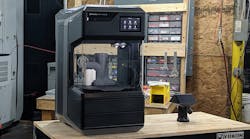The recent Machine Design webcast “How Choosing the Right 3D Printing Materials Maximizes ROI”, sponsored by MakerBot, generated more audience questions than could be answered during the one-hour presentation. The speakers included three experts from MakerBot:
- Vishnu Anantha, Hardware Design Lead
- Karl Schmidt, Manager, Testing and Materials
- Shawn Miely, PRO Segment Marketing Manager
They have provided written responses to some of those additional questions. To review the full Machine Design webcast, click here.
Q: How long does it take to print the average part? Print time is dependent on a number of variables including part complexity, material type, support type, etc.
A: Generally, the parts we print range from as short as 30 minutes for something small and simple to 24 or more hours for a more complex assembly.
Q: How many prototypes would you typically print in the development of a product, and do you also use machined or outsourced 3D printed prototypes?
A: It really depends on the project and stage of the project. For an early concept I might print five versions of the same part just to get feedback from the team, generally using PLA with breakaway supports for this. Later in the process, as we’ve selected a direction, we’ll typically print anything that’s been modified or update just to make sure it fits and is functional.
In addition to our in-house 3D printing capabilities we will also utilize service providers or machine shops for certain applications, such as if we need a machined metal part.
Q: What other types of materials are you working on for METHOD?
A: The beauty of the METHOD platform is that because it is controlling so many environmental variables it is extremely well-suited for more materials than the typical desktop 3D printer. We just launched a materials development program under MakerBot LABS that includes materials like Carbon Fiber ABS, Flame Resistant PC, and ESD PETG, to name a few.
Q: What materials or processes are available to create watertight, non-porous enclosures using fused deposition modeling (FDM)? This is exactly what we are looking at right now [as a] low-volume enclosure manufacturer.
A: If you are looking to make watertight enclosures with FDM, really any material should be able to do this. When making objects watertight, the model’s walls need to be a certain thickness—several millimeters thick, usually—and solid. FDM parts tend to have small voids between the extruded beads and, for features like curved surfaces, those gaps can permit water infiltration; thicker walls will help prevent this. It is still a best practice to have some kind of gasket material in the mating surfaces of the two halves of the enclosure, too.
Keep in mind as well the environment where the part will be used; material properties will drive materials selection. For example, if the enclosure is going underwater and will experience higher pressure, a material capable of handling this pressure without deforming will be necessary. It may take some testing and iteration to determine a final design.
Q: Could you explain the difference between the manufacturing aids and end-use part phase?
A: Manufacturing aids could probably fit under the umbrella of end-use parts, but we break them out because it is such a large subset, and we see about half of our professional customers using our printers for manufacturing aids. You could think of our definition of end-use parts as anything used outside of the manufacturing process.
Q: What concerns are there with submersing a nylon part in water to remove the support material, since nylon absorbs water?
A: Because nylon absorbs water, submerging it in water to remove support will change the material properties. Specifically, the material gets much more ductile; it may also swell slightly. Baking the part at elevated temperature can recover most, if not all, the material’s strength.
Whether this is important is really up to the designer; if the environment the part is going to be used in is wet and rigidity is necessary to the function of the part, then nylon may not be the appropriate materials choice. If strength is less important and wear resistance is a priority, nylon may be the best choice.
Q: What’s your take on metallic/additive manufacturing?
A: Metal has become the new buzz in the additive manufacturing space and it’s easy to see why. In traditional manufacturing metal is king. In reality, 3D printing metal is very expensive, and many of the technologies are unproven when compared to forged and machined metal parts.
Additionally, with the range of new advanced polymers and composites, you can often get parts that exceed many properties of metal without the excess weight and more affordably. Either way it’s a very exciting time to be in the 3D printing space with all of the new innovation.

